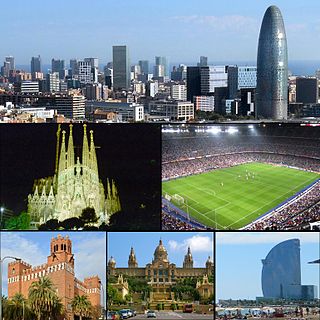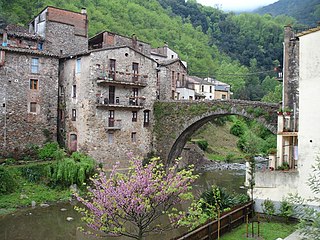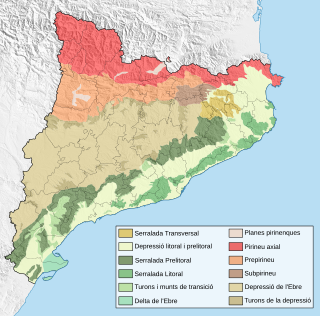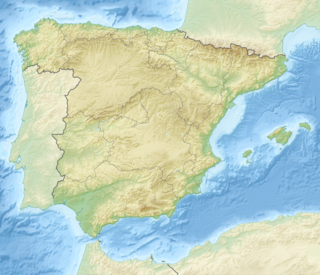| Guilleries | |
|---|---|
| Highest point | |
| Elevation | 1,202 m (3,944 ft) |
| Coordinates | 41°56′34.93″N2°24′49.39″E / 41.9430361°N 2.4137194°E Coordinates: 41°56′34.93″N2°24′49.39″E / 41.9430361°N 2.4137194°E |
| Geography | |
| Location | Selva, Catalonia |
| Parent range | Catalan Pre-Coastal Range and Catalan Transversal Range |
| Geology | |
| Mountain type | Metamorphic rock |
| Climbing | |
| Easiest route | From Sant Hilari Sacalm or from Osor |

The Guilleries Massif (Catalan Les Guilleries) is a mountain system located at the apex of the Catalan Transversal Range and the Pre-Coastal Range. The highest point of the range is Sant Miquel de Solterra or Sant Miquel de les Formigues (1.204 m), other main peaks are Turó del Faig Verd (1,187 m), Rocallarga (1,187 m), Sant Benet (1,149 m), El Far (1,111 m), Sant Gregori (1 ,094 m), Montdois (930 m), L'Agullola (921 m) and Turó del Castell (851 m) [1]

Catalan is a Western Romance language derived from Vulgar Latin and named after the medieval Principality of Catalonia, in northeastern modern Spain. It is the only official language of Andorra, and a co-official language of the Spanish autonomous communities of Catalonia, the Balearic Islands and Valencia. It also has semi-official status in the Italian commune of Alghero. It is also spoken in the eastern strip of Aragon, in some villages of Region of Murcia called Carche and in the Pyrénées-Orientales department of France. These territories are often called Països Catalans or "Catalan Countries".

The Catalan Transversal Range is a system of minor mountain ranges at the eastern end of the Pre-Pyrenees, between the Osona and Garrotxa comarques. The existence of the Catalan Transversal Range has made communications in the northern areas of Catalonia difficult in the past, especially between Northeastern Catalonia and Western Catalonia, a problem that has been partly solved with the development of the Eix Transversal.

The Catalan Pre-Coastal Range is a system of mountain ranges running parallel to the Mediterranean Sea coast in Catalonia. It is part of the Catalan Mediterranean System. Its main axis runs between the Catalan Transversal Range and the Serra de l'Espina, which connects with the Ports de Tortosa-Beseit, part of the Iberian System. The highest point is 1.706,7 m at the Montseny Massif.
Contents
The Guilleries is one of the few places in the Catalan Mediterranean System where amphibolite facies conditions are found. [2] The Pantà de Susqueda and Pantà de Sau reservoirs, of great importance for Barcelona metropolitan water supply, are located in the Guilleries area.

The Catalan Mediterranean System, also known as Mediterranean System, Transversal Ibero-Pyrenaean System, and Catalanid System, is a wide coastal geographical region in Catalonia. It is made up of a double system of coastal mountain chains: The Catalan Coastal Range and the Catalan Pre-Coastal Range, as well as the Catalan Coastal Depression and other coastal and pre-coastal plains located among those mountain ranges.

Amphibolite is a metamorphic rock that contains amphibole, especially the species hornblende and actinolite, as well as plagioclase.

Barcelona is a city in Spain. It is the capital and largest city of the autonomous community of Catalonia, as well as the second most populous municipality of Spain. With a population of 1.6 million within city limits, its urban area extends to numerous neighbouring municipalities within the Province of Barcelona and is home to around 4.8 million people, making it the sixth most populous urban area in the European Union after Paris, London, Madrid, the Ruhr area and Milan. It is one of the largest metropolises on the Mediterranean Sea, located on the coast between the mouths of the rivers Llobregat and Besòs, and bounded to the west by the Serra de Collserola mountain range, the tallest peak of which is 512 metres high.
These mountains were notorious in former times for being a haunt of bandits and highwaymen. [3]
The main towns in the Guilleries area are Sant Hilari Sacalm, Osor, Susqueda, Vilanova de Sau, Sant Sadurní d'Osormort, Espinelves and Viladrau.

Sant Hilari Sacalm is a municipality in the comarca of the Selva in Catalonia, Spain.

Osor is a municipality in the comarca of la Selva in Catalonia, Spain.

Susqueda is a municipality in the comarca of the Selva in Catalonia, Spain. It is located in the Guilleries Massif area, on the left bank of the Ter river in the north-west of the comarca. The Susqueda reservoir is on the municipal territory, and the associated hydroelectric power station is an important source of local income. A local road links the municipality with the C-152 road to Santa Coloma de Farners.












